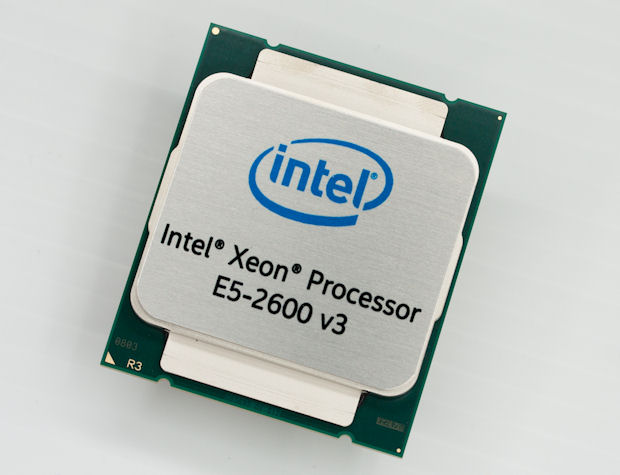New Xeon Processors Accelerate Data Centers
October 22, 2014
When Intel Corp. released its new Intel Xeon processor E5-2600/1600 v3 product families, it described the processors as addressing the diverse workload requirements and rapidly evolving needs of data centers. Formerly codenamed Haswell, the new processor families incorporate enhancements that, Intel says, provide performance increases of up to three times over the previous generation (click here and here for more details), high energy efficiency and enhanced security. With the new Xeon E5-2600 v3 product family, the company introduces key sensors and telemetry to further enhance software defined infrastructure (SDI) for digital delivery services such as cloud computing sites.
Intel anticipates that the E5-2600/1600 v3 processors will be used in servers, workstations, storage and networking infrastructure to power a broad set of workloads such as data analytics, high-performance computing (HPC), telecommunications and cloud-based services, as well as back-end processing for the Internet of Things (IoT). To simplify the demands of SDI, Intel says that the processors expose key metrics through telemetry, which enables the infrastructure to deliver services with the best performance, resilience and optimized total cost of ownership (TCO).
The E5-2600/1600 v3 processors contain platform telemetry sensors and metrics for CPU, memory and I/O utilization. With the addition of thermal sensors for airflow and outlet temperature, visibility and control have increased “significantly” from the prior generation of processors, says Intel. The processors offer a holistic set of sensors and telemetry enabling SDI orchestration solutions to closely monitor, manage and control system utilization, which will help maximize data center efficiency and should provide a lower TOC.
The Intel Xeon processor E5-2600 v3 product family also introduces new features for greater visibility into data center systems, reports Intel. For example, a new cache-monitoring feature provides data to enable orchestration tools to place and rebalance workloads intelligently, which should result in faster completion times. This also provides the ability to conduct analysis of performance anomalies due to competition for cache space in a multitenant cloud environment where there is little visibility into the type of workloads consumers run.
With up to 18 cores per socket and 45MB of last-level cache, the Intel Xeon E5-2600 v3 product family delivers up to 50% more cores and cache compared to the previous processor generation. In addition, an extension to Intel Advanced Vector Extensions 2 (Intel AVX2) doubles the width of vector integer instructions to 256 bits per clock cycle for integer-sensitive workloads and delivers up to 1.9 times higher performance gains compared to earlier generations, according to Intel.
Intel says that the Xeon E5-2600 v3 product family provides increased virtualization density, which allows support for up to 70% more virtual machines (VMs) per server compared to its predecessors. Memory bandwidth-constrained workloads see gain of up to 1.4 times higher performance compared to the previous generation with the support of next-generation DDR4 memory. Furthermore, Intel Advanced Encryption Standard New Instructions (Intel AES-NI) see enhancements that accelerate data encryption and decryption by up to two times without sacrificing application response times.
The E5-2600 v3 processors are built using Intel’s 22nm, 3-D Tri-Gate technology, which Intel says, cuts power consumption while boosting transistor performance. The company adds that new “per-core” power states dynamically regulate and adjust power in each processor core for more power-efficient workload processing.
Intel Xeon E5-2600 v3 processors can be paired with the Intel Communications Chipset 89xx series featuring Intel Quick Assist Technology, which, the company reports, will enable faster encryption and compression performance for improved security in a wide range of workloads. Intel says that service providers and networking equipment providers can use the platform to consolidate multiple communications workloads onto a single, standardized and flexible architecture to speed up services deployment, reduce costs, and create a more consistent and secure user experience.
Additionally, the new Intel Ethernet Controller XL710 family helps address the increasing demands on networks with capabilities to enable better performance for virtualized servers and networks. The flexible 10/40-gigabit Ethernet controller provides twice the bandwidth while consuming half the power compared with the previous iterations, says Intel.
“The digital services economy imposes new requirements on the data center, requirements for automated, dynamic and scalable service delivery,” said Diane Bryant, senior vice president and general manager of the Data Center Group at Intel, in the announcement of the Xeon E5-2600/1600 v3 product families. “Our new Intel processors deliver unmatched performance, energy efficiency and security, as well as provide visibility into the hardware resources required to enable software defined infrastructure. By enabling the re-architecture of the data center, Intel is helping companies fully exploit the benefits of cloud-based services.”
For further details on the new Intel Xeon processor E5-2600/1600 v3 product families, visit Intel.
See a video introduction of the Intel Xeon processor E5-2600 v3 family.
Read the Xeon processor E5-2600 v3 product brief.
Watch a video on the Xeon E5-2600 v3’s performance potential.
Watch “Delivering on the Promise of Personalized Medicine.”
Learn more about virtualization technologies.
Sources: Press materials received from the company and additional information gleaned from the company’s website.
Subscribe to our FREE magazine, FREE email newsletters or both!
About the Author
Anthony J. Lockwood is Digital Engineering’s founding editor. He is now retired. Contact him via [email protected].
Follow DE







